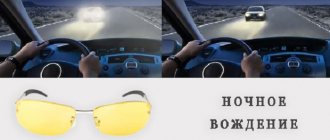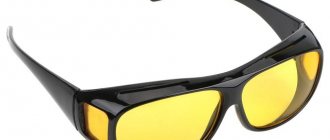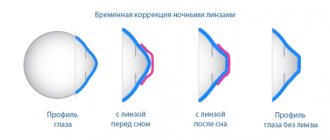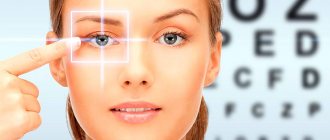What other indicators are taken into account during a vision test?
No less important is the color perception indicator.
To check it, the Rabkin table is used. If, based on the results of the test, it turns out that the driver has impaired color vision for green and red, the issuance of a driver's license will be denied, since it is believed that the driver will not be able to distinguish between the colors of the traffic light.
Despite the fact that in practice this defect does not interfere with distinguishing traffic lights, because the driver remembers the switching sequence, obtaining a license with such a deviation is prohibited. In some countries, to solve this problem, they plan to use different forms of lamps for traffic lights to eliminate the possibility of confusing signals for drivers with such a defect.
Categories “B” and “C” can be opened with minor deviations, provided that the applicant distinguishes the colors of the traffic light.
Another indicator of normal vision function that gives permission to drive is horizons. Narrowed vision of the eyes is usually a symptom of certain diseases. If it is present, the view is extremely narrowed. According to standard indicators, it should not be less than 20 degrees. This defect cannot be corrected with the help of corrective devices, just like color blindness. Therefore, if the indicators are exceeded, the subject will not receive permission to drive.
Colorblindness
A driver’s color perception is an important factor influencing the medical board’s decision to allow him to drive. Previously, with a diagnosis of color blindness, a driver's license was issued, but later this factor became a limitation with which it was impossible to obtain a license. Color blindness is checked using the Rabkin table:
Failure to recognize colors on the table means that the person is color blind. With such a diagnosis, a driver's license will not be issued. It is believed that a driver with color blindness may react incorrectly to traffic lights.
Examination by an ophthalmologist
How to learn to drive a car - advice from a car lady
An examination by an eye specialist at a driver's medical commission consists of several areas:
- Determination of visual acuity using basic ophthalmological diagnostics (tables for checking actual acuity), refractometric methods (determining the focus of vision using special equipment).
- Diagnosis of color perception and its disorders (polychromatic tables, Rabkin tests).
- Study of visual fields (simple and highly accurate methods), breadth of horizons.
IMPORTANT! With the help of contact lenses and glasses (no higher than 8 diopters), you can achieve acceptable vision correction and obtain a positive opinion from an ophthalmologist about permission to drive a vehicle. The permissible difference between the optical glasses for the left and right eyes should not exceed 3 units
In this case, a special mark is made on the driver’s license (for example, “driving with glasses”).
Obtaining a driver's license with visual impairments
How to issue a general power of attorney for a car with the right to sell
When renewing or obtaining a license, the driver attends a medical examination, which also includes a vision test and, accordingly, a visit to an ophthalmologist - a necessary condition.
At the beginning of 2015, a new government decree on medical contraindications for vehicle drivers came into effect (adopted at the end of 2014). At the same time, restrictions for ordinary drivers and professional ones began to differ at the legislative level.
Let's look at specific vision limitations for obtaining a driver's license for different categories, as well as the diagnostic procedure itself and what it includes.
Medical examination for vision
The check includes diagnosing:
- visual acuity;
- color perception;
- viewing width;
- ophthalmological diseases.
Visual acuity
Vision is diagnosed using a special table by Sivtsev or Golovin. If the driver uses glasses or contact lenses, their vision is checked directly while wearing them.
Restrictions on obtaining driver's licenses
Non-professionals of categories A and B (motorcycle and passenger transport):
- vision for a good eye – not less than 0.6; for the second – no less than 0.2 (no matter which eye sees better);
- if one of the eyes is blind, the other must have a vision level of at least 0.8 with any correction;
- at least one month after eye refractive surgery.
Professionals of categories A and B and drivers of categories C, D, E, Tm, Tb (various types of trucks, buses, trams and trolleybuses):
- vision of the first eye – not less than 0.8; the second – 0.4 (and if both eyes are open, vision should be at least 0.7);
- Corrective agents cannot be used more than plus or minus 8.0 diopters, and the difference between the eyes can be no more than 3.0 diopters;
- for astigmatism - the sum of the cylinder and sphere should be no more than 8.0 diopters, and between the eyes - 3.0 diopters.
- if one eye is blind, the other must have visual acuity of at least 0.8 without correction.
- the absence of chronic eye diseases that interfere with the normal functioning of the visual apparatus and cannot be treated: cuts in the muscles of the eyelids, diplopia, paralytic strabismus, optic nerve paralysis, retinal detachment, glaucoma and others (after a successful operation to eliminate them, licenses can be issued based on the results of an individual examination );
- absence of spontaneous nystagmus (position of the eyeballs seventy degrees from the correct one).
Level of color perception
To obtain a driving license, you must also undergo a color vision test. The driver's perception of color has not previously been a reason for restrictions. But later they found out that if the driver incorrectly distinguishes the colors of the traffic light, this can lead to tragic consequences. After this, people with color vision disorders were prohibited from professionally driving any vehicles.
Color perception is checked using Rabkin’s polychromatic tables:
It consists of sheets on which different elements are depicted, usually numbers, of the same brightness, but different in color. To a person with disabilities, it seems that the picture is entirely one color, but a healthy person can distinguish elements of different colors. The more images are recognized incorrectly, the stronger the level of anomaly. Color blindness is incurable and cannot be corrected.
Field of View Width
To obtain a driver's license, the candidate's viewing width is also checked. It should not be limited to more than twenty degrees, either vertically or horizontally.
Like color vision impairment, vision loss cannot be corrected with lenses or glasses.
Other obstacles and tips
What other factors may become an obstacle to obtaining rights? Candidates are required to undergo surgical treatment for:
- persistent changes in the mucous membranes of the eyes and extraocular muscles;
- pathologies of the lacrimal sac;
- diplopia (i.e., double objects in the eyes) due to strabismus;
- retinal detachment;
- optic nerve atrophy;
- glaucoma.
Acceptable indicators
You have already decided to switch from public transport to driving your own car, have saved up the amount necessary to study at a driving school, found out that in order to enroll you will need to pass a medical examination, and finally, you are thinking about whether you can satisfy the requests of doctors.
An ophthalmologist will be among the doctors who will test you. He will determine and record your visual acuity level on your certificate.
Acuity
You need to know that the acceptable vision for a driver's license has a minimum.
- For category B, the visual acuity of the strongest eye must reach a minimum of 0.6 units. The weaker eye can see 0.2 units. If you “meet” these indicators, you will receive permission to drive based on your vision from your eye doctor.
- For category C, vision must be better to obtain a driver's license. The most seeing eye should see at the level of 0.8 points, and the weakest - at the level of 0.4 points. People who have sufficient quality of vision are guaranteed to receive a vision permit.
If your vision is poor, and not as good as described above, you will be included in the list of people who are subject to vision limitations.
What should I do if I wear glasses?
Wearing glasses or lenses is not an obstacle to driving. However, if you use eyepieces, you should definitely come to the ophthalmologist with them. Then your vision will be checked using drugs that enhance your vision.
But it’s worth making a reservation that then you will always have to drive with glasses or contacts. The doctor will record such a requirement in the certificate.
We also note that this rule applies only to drivers of category B. If a person is going to take the test for category C, he will have to have his eyesight checked with “naked” eyes.
Colorblindness
Today it is almost impossible for people suffering from color blindness to obtain admission. Restrictions regarding their illness came into force in 2012. Since then, those who are color blind have been banned from driving.
There is a logical basis for such a decision. After all, a person with a color perception disorder will not be able to navigate well in signs that differ in nature, including colors, and will also be unable to recognize traffic light signals.
Many people suffering from the disorders described will be outraged. After all, color blindness varies in its extent and one cannot equate people with slight deviations in color vision to those who completely lose some color from their perception.
However, the rules and laws are ruthless. Now even those who have minor deviations will not be given permission to study at a driving school. Colorblind people are considered dangerous on the road.
A little about everything
Photo of car license
Every year the number of car enthusiasts is growing. After all, nowadays a car is not a luxury, but just a means of transportation. For this reason, many driving schools are simply overcrowded with people who want to learn and get a license.
However, to issue a driver's document, you must not only know the traffic rules well, but also pass a medical examination. This is where many citizens face numerous difficulties. In particular, this is due to the fact that the medical commission includes an ophthalmologist who cannot allow a person with poor vision to drive a vehicle.
This is important to know
So with what kind of vision will a person be allowed to drive a car? This is a very interesting question. So, a person will definitely be allowed to drive a vehicle if his visual acuity in both eyes is at least 0.7 units. You need to know about this.
How long will the results be valid?
If the visual system is not functioning properly, the driver has a greater chance of causing an accident. Therefore, health indicators are clearly defined under which it is impossible to issue licenses and drive cars.
After your vision has been tested, if the result is successful, it will be included in the certificate, which will subsequently have to be submitted to issue a certificate. The document has a short validity period. If during this period it is not possible to obtain a driver’s license, the verification will have to be done again.
The effect of a document confirming a person’s capabilities will be as follows:
- For those wishing to drive their own car in satisfactory health – three years.
- For those who work as a hired driver – two years.
- For driver candidates under 20 or over 50 years of age, as well as for those with health conditions, the certificate is valid for one year.
Minimum driving requirements
To be able to drive a car, visual impairment must be within acceptable limits. Ophthalmologists use the designations V - visual acuity (a line that a person can clearly distinguish in a letter table), D - the distance from which the subject sees the lines clearly. The norm is V=1.0, at D=5.0.
Minimum indicators:
- “B” (passenger car) - V=0.6 for two eyes or for the one whose vision quality is better or V=0.2 for the worse eye;
- “B” (passenger transportation, special purpose transport) - V=0.8 and 0.4 on one and the other eye;
- “C” - V=0.7 for both eyes or 0.8 and 0.4 for different eyes.
People with visual problems should not drive a car without glasses. The difference between the two eyepieces should not exceed 3D, a deviation from the norm of no more than 8D is permissible.
If a person has one eye completely inoperative, the vision of the second without glasses should be normal or deviate by V=0.8. These indicators are valid provided that the driver does not have other pathological abnormalities - color blindness, narrowing of the field of vision.
Medical examination for vision
The check includes diagnosing:
- visual acuity;
- color perception;
- viewing width;
- ophthalmological diseases.
Visual acuity
Vision is diagnosed using a special table by Sivtsev or Golovin. If the driver uses glasses or contact lenses, their vision is checked directly while wearing them.
Restrictions on obtaining driver's licenses
Non-professionals of categories A and B (motorcycle and passenger transport):
- vision for a good eye – not less than 0.6; for the second – no less than 0.2 (no matter which eye sees better);
- if one of the eyes is blind, the other must have a vision level of at least 0.8 with any correction;
- at least one month after eye refractive surgery.
Professionals of categories A and B and drivers of categories C, D, E, Tm, Tb (various types of trucks, buses, trams and trolleybuses):
- vision of the first eye – not less than 0.8; the second – 0.4 (and if both eyes are open, vision should be at least 0.7);
- Corrective agents cannot be used more than plus or minus 8.0 diopters, and the difference between the eyes can be no more than 3.0 diopters;
- for astigmatism - the sum of the cylinder and sphere should be no more than 8.0 diopters, and between the eyes - 3.0 diopters.
- if one eye is blind, the other must have visual acuity of at least 0.8 without correction.
- the absence of chronic eye diseases that interfere with the normal functioning of the visual apparatus and cannot be treated: cuts in the muscles of the eyelids, diplopia, paralytic strabismus, optic nerve paralysis, retinal detachment, glaucoma and others (after a successful operation to eliminate them, licenses can be issued based on the results of an individual examination );
- absence of spontaneous nystagmus (position of the eyeballs seventy degrees from the correct one).
Level of color perception
To obtain a driving license, you must also undergo a color vision test. The driver's perception of color has not previously been a reason for restrictions. But later they found out that if the driver incorrectly distinguishes the colors of the traffic light, this can lead to tragic consequences. After this, people with color vision disorders were prohibited from professionally driving any vehicles.
Color perception is checked using Rabkin’s polychromatic tables:
It consists of sheets on which different elements are depicted, usually numbers, of the same brightness, but different in color. To a person with disabilities, it seems that the picture is entirely one color, but a healthy person can distinguish elements of different colors. The more images are recognized incorrectly, the stronger the level of anomaly. Color blindness is incurable and cannot be corrected.
Field of View Width
To obtain a driver's license, the candidate's viewing width is also checked. It should not be limited to more than twenty degrees, either vertically or horizontally.
Like color vision impairment, vision loss cannot be corrected with lenses or glasses.
Other obstacles and tips
What other factors may become an obstacle to obtaining rights? Candidates are required to undergo surgical treatment for:
- persistent changes in the mucous membranes of the eyes and extraocular muscles;
- pathologies of the lacrimal sac;
- diplopia (i.e., double objects in the eyes) due to strabismus;
- retinal detachment;
- optic nerve atrophy;
- glaucoma.
Visual restrictions for category B drivers
Passing an examination by an ophthalmologist
The vision requirements for drivers are high. The ability to drive a vehicle alone is not enough. First of all, visual perception influences a positive result in obtaining a license.
A person with poor eyesight is referred to an ophthalmologist before taking a driving school so that he does not waste money on training.
Color blindness test
This testing involves Rabkin's pictures. The patient is seated at a distance of 1 m from the images. Then they show the shapes printed on paper using different colors.
The patient names the depicted figures/numbers. Testing allows you to determine whether a person has deviations in color vision. It consists of 24 images.
Color blindness test
If a patient is diagnosed with “protanopia” (immunity to red) or “deuteranopia” (immunity to green), a driver’s license will not be issued. Violation of red color receptors is the most common case.
If color vision is normal, a diagnosis is made - normal trichromatism. Some people do not distinguish colors at all; they see the world in black and white. This disease is called achromasia.
Testing can also be done at home using a computer. The main thing is not to get close to the monitor; numbers and figures should be viewed from a distance of at least 1 m. Color calibration on the monitor plays an important role, so it is recommended to visit a doctor.
Outlook test
Excellent visual acuity is not enough to obtain a driver's license. When passing a medical commission, they evaluate their horizons. Normally, it is at least 20 degrees; at lower levels, it is prohibited to drive any vehicle.
Its narrowing indicates pathological conditions, including retinal detachment. Assessing your horizons is necessary to reduce the risk of accidents on roads, especially with three-lane markings.
The patient turns to the ophthalmology center to solve this problem through surgery. If 3 months after this the horizon is at least 20 degrees, the ophthalmologist will give permission to obtain a driver's license.
For category A
— Visual acuity is below 0.6 and 0.2 in one and the other eye with correction. Correction of myopia and farsightedness of 8.0D, including correction with contact lenses, as well as astigmatism of 3.0D (the total value of the sphere and cylinder must be below 8.0D) is considered acceptable. The difference in the optical power of the lenses of both eyes is up to 3.0D.
— Lack of vision in one eye with vision up to 0.8 in the other (without correction).
- Central scotoma, absolute or relative (for scotoma with changes in visual functions above the values of the first point - admission without restrictions).
— Acceptable correction of myopia and farsightedness up to 8.0D, including correction with contact lenses, as well as astigmatism – 3.0D (the total power of the sphere and cylinder must be less than 8.0D). The difference in the optical power of the lenses of both eyes should be up to 3.0D, without complications, with the initial refraction - from +8.0D to -8.0D. If it is impossible to establish the initial refraction (due to surgery), the issue of professional suitability is resolved positively if the length of the eye axis is 21.5 - 27.0 mm.
— Artificial lens, even on one of the eyes. Only experienced drivers with visual acuity above 0.6 with correction in the best eye and above 0.2 in the worst are allowed. Acceptable correction of myopia and farsightedness is 8.0D, including correction with contact lenses, as well as astigmatism - 3.0D (the total optical power of the sphere and cylinder must be below 8.0D).
— Conditions after surgical interventions on the cornea (keratotomy, keratocoagulation, keratomylosis, refractive keratoplasty). Persons are allowed to drive 3 months after surgery with visual acuity above 0.6 and 0.2 in the best and worst eyes with correction.
— Chronic pathologies of the membranes of the eye against the background of significant changes in visual function, persistent lesions of the eyelids, including their mucous membranes, paresis of the eyelid muscles that can interfere with vision or limit the motor activity of the eyeballs (after surgical treatment that has brought a positive result, admission is determined strictly individually).
— Chronic conservative treatment of the inflammatory process of the lacrimal sac, which does not bring positive results, persistent lacrimation that cannot be treated.
Paralytic strabismus, as well as other lesions of the conjugate movement of the eyeballs. Persistent diplopia due to strabismus of any nature. Spontaneous nystagmus, if there is a deviation of the pupils from the average position by 70°. Limitation of the field of view in any meridian by more than 200°.
- Color vision disturbances.
— Diseases of the retina and optic nerve (optic atrophy, retinitis pigmentosa, retinal detachment, etc.).
- Glaucoma.
Vision for driving license categories A, M (A1, B1)
The requirements for two-wheelers are similar to those for cars, but there are important differences:
1. Visual acuity is below 0.6 in the best eye and below 0.2 in the worst eye with tolerable correction with 2 eyes open, regardless of the type of correction (spectacles, contact, surgical), the degree and type of ametropia or eye length.
2. Blindness of one eye with visual acuity below 0.8 with tolerable correction in the sighted eye, regardless of the type of correction (spectacles, contact, surgical), degree and type of ametropia or eye length.
The main difference is that special requirements apply to a driver who is missing one eye. Such a driver must have a visual acuity of 0.8 or more in his only eye.
A certificate for category A can be obtained in the following cases:
- 0.6 or more - in the better eye, if both eyes see.
- 0.2 or more - in each of the two eyes.
- 0.8 or more if there is only one eye.
Also, for category A and M licenses, the use of corrective devices (glasses, lenses) is allowed.
Determination of visual acuity
The specialist will check this indicator first. The test will consist of reading optotypes (certain symbols) of a special table from a distance of 5 meters. First, one eye is examined, then the other. In the case when a person manages to read line 10 without problems, they are diagnosed with 100% vision - everything is in order. If the tenth line cannot be read, visual acuity is determined by further reading lines 9, 8, 7, etc.
It is worth keeping in mind that driving a car with impaired visual acuity is only possible with glasses or contact lenses. Therefore, if a person already has correction means, the study is carried out using them. In this way, the ophthalmologist will determine visual acuity and its suitability for obtaining a driver’s license and driving a car.
Very often, potential drivers are interested in the question: is it possible to get a license if you have chameleon eyes? It’s worth immediately reassuring everyone concerned about this problem: eye color cannot affect visual acuity, and therefore the possibility of obtaining a driver’s license.
Visual acuity test
Visual acuity is one of the most important indicators that are checked for drivers. It is diagnosed using the familiar table. By the way, it is not recommended to teach it; an ophthalmologist checks your vision using several methods and will quickly expose you.
There are the following vision restrictions for obtaining a driver's license:
- If you are applying for a category B license, you must have vision of 0.6 or higher in one or both eyes. If vision is uneven in the worse-seeing eye, it should be at least 0.2.
- If you need professional licenses of various categories, it is necessary that the vision of one or both eyes is at least 0.8. If vision is uneven in the worse-seeing eye, it should be at least 0.4.
- If a potential driver uses corrective devices, then the distortion of the lenses should be no more than eight diopters, and the amplitude should not be more than three diopters.
- If a potential driver is blind on one side, then the other eye must have its own (without the use of correction means) vision of at least 0.8 units.
Medical commission
It is the responsibility of drivers to undergo a medical examination before obtaining a license. It is impossible to obtain a driver's license without a certificate with opinions from doctors in various fields. You can undergo a medical examination only in an institution that has a special license.
A medical certificate confirming the absence of contraindications for driving a category B vehicle must be obtained from:
- ophthalmologist (ophthalmologist);
- narcologist;
- psychiatrist;
- neurologist;
- gynecologist (for women);
- therapist.
Until 2021, the list of specialists was much larger. Now the responsibilities of the therapist include carrying out the conclusions of the otolaryngologist and dermatovenerologist, as well as surgical ones.
In addition, the potential driver is required to undergo tests:
- submitting urine to determine the presence of drugs in the body;
- donating blood to determine the Rh factor;
- electrocardiogram of the heart.
Refusal to undergo laboratory tests makes it impossible to obtain a medical report.
An examination by a therapist is the most time-consuming process, because it is he who issues the final conclusion of the commission. If difficulties arise when issuing a conclusion, the therapist has the right to send the driver for an additional examination to a doctor.
Based on the results of the medical examination, a medical certificate is issued.
The validity period of this certificate varies:
- ten years – for all drivers of personal transport in excellent health;
- two years – if a person’s work involves transportation and driving (for drivers);
- one year – for drivers with health problems;
- Every time before a long trip, drivers of organizations must undergo a commission.
Full medical examination procedure
The candidate can undergo the medical examinations necessary for admission to take a training course at a driving school at any of the specialized institutions. The only important factor is the fact that the clinic must have a state certificate for qualified medical examinations.
If you have serious chronic diseases or pathologies, you must take with you a card containing medical records and extracts from the medical history. A detailed study of this information will allow specialists to make a reasoned and most correct conclusion regarding the ability to drive a car.
Basically, the price depends on the region and level of the hospital you decide to go to.
Depending on the results of the inspection, a certificate for obtaining a license to drive a personal vehicle is issued for the following period:
- 3 years - for drivers of personal cars without any health impairments.
- 2 years - for people who plan to work as drivers of freight or passenger transport.
- 1 year - for persons applying for a license who have not reached 20 years of age or are over 50 years of age.
- If an applicant driver exhibits deviations from normal health indicators, then a license is also issued for a period of no more than 1 year.
Fine for driving without glasses in 2018
If there is a note on the driver’s license that he must drive a car with glasses/lenses, but he drives without them, he risks being punished for this.
Interesting fact: there is no article in the legislation of the Russian Federation that talks about driving without glasses. Therefore, for such a violation, drivers are treated as responsible for driving without a license. That's why there are such large sums for driving without glasses.
But keep in mind that if an employee of the State Traffic Inspectorate reveals a violation and catches the driver for driving without glasses, he will incur additional costs. After all, his car will be taken to the impound lot.
In the future, he will have to pay money for the towing of the vehicle and its storage until the violation is eliminated.
In some cases, a fine can be avoided if the driver proves to the inspector that he did not have time to put on his glasses, but they are lying next to him.
Imperfect vision is not always a stumbling block for drivers who want to get a license. To the question of many forum members: “What line do you need to see in order to smoothly obtain access to your license?” The answer is clear: “The very bottom.”
But even if your vision is blurry, you can get admission, because no one has canceled contact lenses and glasses.
Remember that driving without corrective means increases the danger on the road. Therefore, think about other people, be sure to wear glasses/lenses to not only avoid a fine, but also traffic accidents.
Fines for driving without glasses or contacts
Not all drivers are obedient citizens. Many people ignore the rules and do not wear vision correction devices. The fines provided for by the Legislation of the Russian Federation were not introduced in order to replenish the treasury, but to punish people who are capable of creating an emergency situation on the road.
There is no information in the Traffic Rules about the need to wear glasses if you have poor vision, and there are no direct instructions in the Code of Administrative Offenses for driving without them. However, there is a law “On Road Traffic Safety”, according to which the driver can be fined 5-15 thousand rubles and the car can be towed to an impound lot.
The fine for driving without glasses and lenses is paid with a 50% discount if done within 20 days from the date of the relevant decision. This is indicated in Article 32.2 of the Code of Administrative Offenses of the Russian Federation.
There is nothing in the law about lenses. According to him, people with poor vision should wear glasses. If a person wears lenses, he is not required to take them out and present them to the inspector. It is enough to show a container or other object indicating the presence of CL in the eyes.
An offense occurs if a person does not wear vision correction devices specified on the driver's license. Not only a fine is possible, but also the opening of a court case.
Officially, it is impossible to avoid a fine. The only option is to cheat by saying that there are lenses and you can’t get them due to the lack of a container and hygienic conditions on the road.
How to choose the right sunglasses
The task of choosing the right sunglasses is sometimes not an easy one. There are now so many forms and configurations of this accessory, and every year the market becomes more and more saturated. It’s hard not to get confused and you want to be confident in your choice after the purchase. It is not difficult.
Glasses should be selected according to your face type
How to choose sunglasses according to your face shape?
First of all, glasses are selected according to the shape and type of face, but there are small nuances here...
For an oval face
For those who are lucky or have an oval face, the green light is everywhere, including when choosing sunglasses. You can only be guided by your own desire. Absolutely all types of glasses suit an oval face.
You can play around with frames to your heart's content. Both delicate thin frames and elaborate contrasting frames would be appropriate.
When selecting, pay attention to the relationship between the eyebrow line and the top line of the frame
For square faces
If your face is square, you should try to soften it as much as possible. This can be successfully done by remembering the advice of your hairdresser and makeup artist about the nuances of your face shape.
It would be better to avoid pointed corners and rectangular shapes
Instead, pay attention to models that exactly match the width of the face with calm, unobtrusive frames. This will help balance
For a round face
Lovely women with a round face should avoid round glasses. But the square ones with a wide arch are definitely worth trying on
It is better to pay attention to sunglasses with a slightly elongated shape. An oval-shaped “cat’s eye” with calm, discreet colors looks elegant.
Dark, bright, rich frames will more strongly emphasize the roundness of the cheeks, which is why it is better to avoid them.
For triangular face shape
With a triangular face, round and oval shapes of sunglasses will be very useful. Light, light frames are also good. It’s better to move all slightly elongated shapes, like the same “cat’s eye” and “butterfly”, further away, they will not fit. Large glasses with heavy geometric shapes are also not suitable.
For diamond shaped face
With the common diamond shape, you need to choose glasses that are the same width as your cheekbones and slightly wider at the bottom. Delicate, fragile frames and frames with sharp corners are absolutely not suitable.
For long face shapes
If you have an elongated shape, you need to take a closer look at glasses with wide frames; narrow frames will make an elongated face even more disharmonious. Small frames won’t work either, but large, bright, colored glasses will look much more interesting.
Frame shapes depending on face type
Nuances on how to choose the right sunglasses
Before purchasing, you need to clearly determine for what purpose the purchase is being made. When choosing an accessory, it is still necessary to be guided not only by aesthetic considerations, because sunglasses are primarily designed to protect the eyes from bright sunlight, ultraviolet radiation and prevent the appearance of facial wrinkles around the eyes.
If you have vision problems, you should consult an ophthalmologist; he will warn you about possible restrictions. Normal quality glasses should be purchased only in specialized salons and stores.
A quality product does not have to cost an exorbitant amount. Be sure to carefully study the labeling and do not neglect the advice and explanations of the consultant.
UV eye protection
Lens material matters:
- It is believed that the lenses of higher quality accessories are made of glass. But experts remind us that glass is a hazardous material, especially if the owner leads an active lifestyle.
- Modern materials for lenses are plastic, polycarbonate. It is worth opting for polarized lenses. They block glare and reflections that impair visibility. It is an ideal choice for drivers and people with photophobia.
- Photochromic lenses are more advanced and are able to transmit the optimal amount of light for the eyes, regardless of weather conditions. They are used in chameleon glasses.
In any case, the correct selection of sunglasses must be approached very responsibly, this is the only way you will maintain eye health for many years.
Actions before passing the medical examination
Medical certificates are required
And it doesn’t matter what category of license a person is going to get
If you have doubts about the normal functioning of the visual system, in particular, decreased acuity or problems with color perception, you should use the following recommendations:
- You need to find a qualified ophthalmologist and get checked. It is advisable that the specialist knows how to properly select corrective products for the eyes. If the glasses are chosen incorrectly, medical certificates will simply not be issued. Since each category has its own indicators, it is impossible to do without professional consultation with an ophthalmologist.
- Your doctor may recommend taking a course of vision stimulation using a special device.
- You should know that the severity changes throughout the day. It is influenced by the state of the body. Therefore, before the day when the diagnosis will be carried out and directly on the appointed day, it is necessary to minimize stress, both physical and psychological. The consumption of alcoholic beverages will be inappropriate. The severity may be worsened by severe anxiety.
What type of vision will not give you a driver's license?
The Ministry of Health has prepared a list of pathologies and various reasons that will be an obstacle to permission to drive a car. Among them are problems with the functioning of the musculoskeletal system, problems with the mental state, deafness, loss of limbs and others. An unconditional visual limitation for obtaining a driver's license will be:
- Diplopia (objects in the field of vision begin to appear in two);
- Some stages of glaucoma;
- Pathological conditions of the eyelid muscles;
- Disturbances in the functioning of the lacrimal sac;
- Retinal disinsertion;
- Dying optic nerve;
- Any pathology of the mucous membrane of the eye.
Among the requirements regarding the ability to see for drivers is a ban on obtaining permits after surgery to correct ophthalmological pathology. It lasts for three months.
If any factors are found that do not allow you to obtain a driver's license, after eliminating them through operations, you can try to pass the test again.
For example, problems with the functioning of the lacrimal sac can be corrected through surgery. If it is successful, after some time you can try again to get permission to drive a car.
Commission vision testing for future drivers
A variety of health checks, including eye assessments, are carried out for drivers in order to ensure safety for all participants while driving on roads. Good vision helps to drive a car in strict accordance with the rules. If there are problems with the condition of the eyes, the enterprise simply becomes dangerous - this increases the likelihood of emergency situations and significantly increases the risk of injury.
If vision does not correspond to the norm, drivers have an increased chance of causing an accident or causing one by incorrectly assessing the situation on the road. Therefore, it is necessary to be attentive to the health of the visual organs if a person wants to drive independently. During a medical examination by an ophthalmologist, the following possibilities are assessed:
- Degree of color sensations;
- Line of sight;
- Visual acuity.
To correctly determine visual acuity, the Sivtsev table is used. It uses the Russian alphabet; on the poster the signs are placed so that in each line their size is slightly smaller. The subject is placed at some distance in front of the table, from where he will have to read the letters indicated by the specialist. Visual acuity will be determined by which of the rows he can accurately identify the letters.
To obtain results during eye tests, the Golovin table can also be used - it uses rings arranged in 12 rows and gradually decreasing in size. The test is carried out as follows: the specialist asks the subject to name some signs, which he himself will point out. When working with such a table, the candidate driver will have to indicate on which side of the ring the gap is located.
If there are problems in this area, some even try to memorize the vision table for drivers. This is not difficult to do - it uses only a few letters of the Russian alphabet. But the deception will most likely be unraveled. In addition, if incorrect information is provided as a result of an erroneous inspection, many people experience problems during subsequent inspections.
If a test is carried out by an eye doctor for a driver's commission, and the subject wears lenses or glasses, he will have to read the letters from the material without removing them. The certificate issued based on the results will indicate that the vision indicators were recorded for the person while using corrective devices. It must be borne in mind that obtaining a vision permit for drivers wearing glasses or lenses obliges them to drive a car only with the use of corrective elements. If you don't have them, you can get a fine for a considerable amount - driving without glasses for people with vision problems is almost equivalent to driving without a driver's license.
What vision is considered normal to get a license?
To obtain all driver's documents, you do not need to have excellent eyesight. Despite the rather strict requirements for this area, even with a slight deviation from the ideal, you can be given the necessary certificate. But the indicators must still be within the limits established by law.
Visual acuity indicators that are considered acceptable for obtaining a driving license:
- The rules for vision for a car with category B are as follows: for the eye that sees better, a value of at least 0.6 is allowed. For the second, who may not see so well, indicators of 0.2 can be considered normal. With the same acuity on both organs, the indicator is considered optimal if at least 0.7 units are determined for both at once. The table by which vision is determined can be viewed during the test while wearing glasses or together with lenses if the subject wears them constantly.
- For a driver intending to receive category C, vision is allowed within the range of 0.8 for one eye and 0.4 for the other. The use of eyepieces during the inspection process is not intended.
- The vision standards for drivers planning to take category A should be 0.6 and 0.2. For those who do not have an eye or one does not see, it is also possible to obtain a license with open category A, if the second organ has an acuity index of at least 0.8.
Additional vision requirements:
- When wearing contact lenses or glasses, the ability to support visual ability should not exceed 8 diopters - this is true for both positive and negative vision.
- The difference in the characteristics of lenses or glasses should not be more than three diopters.
- In the eyes, the visual field width is not allowed to be less than 20.
If we summarize what the vision of a driver undergoing a commission should be, the data will be as follows. It is allowed to approve the certificate for people who have trichromatic, that is, normal color perception, with a breadth of horizons of more than 20 degrees, who can easily examine the tenth line in the tables approved by the Ministry of Health.
A small characteristic
Here it must be said that without a vision diagnosis from an ophthalmologist, a citizen will not be allowed to drive. A medical examination by this specialist is necessary to ensure that the driver, due to poor vision, is not able to create an emergency situation on the roadway. After all, the life and health of other road users may depend on this. A driver with poor vision may not notice a person walking across the road or a sign. This can lead to an accident with very serious consequences.
Thus, ophthalmologists try to pay special attention to checking the vision of all drivers without exception. After all, this is one of the main components of road safety.











